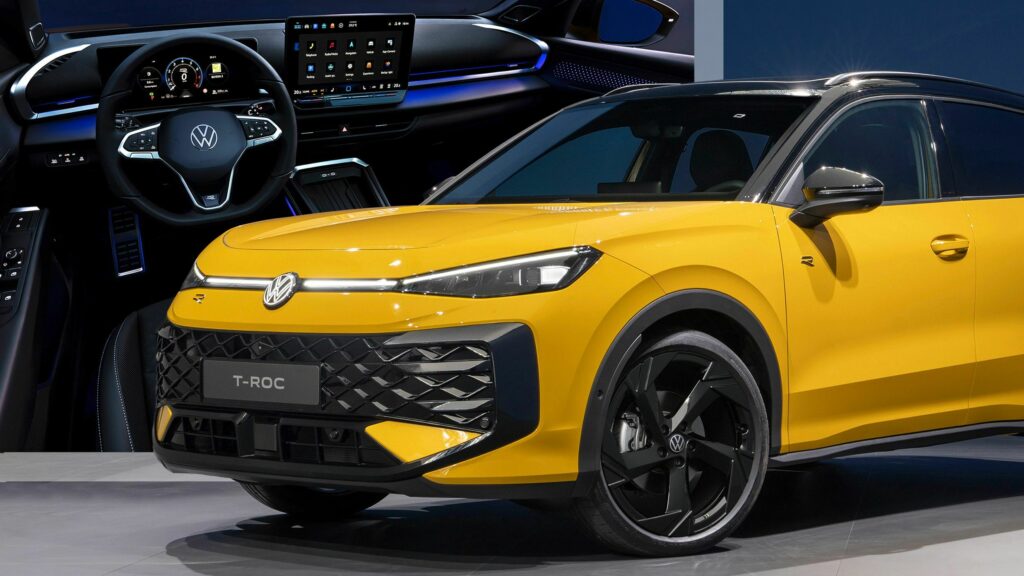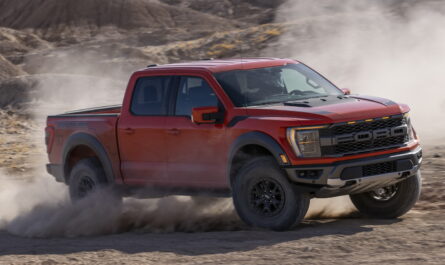Volkswagen has taken the wraps of the second-generation T-Roc eight years after the debut of the original. The Golf-based crossover gains a larger body with fresh styling cues inspired by the ID family of EVs, and an overhauled interior with the latest tech features and upgraded quality. Furthermore, the powertrain lineup gains a full-hybrid option, which is a first for the VW Group.
The exterior design represents an evolution of the original theme with improved proportions and a more aggressive stance. The EV-style face adopts a grille-less look, with a full-width LED bar connecting the headlights with the illuminated emblem. This is combined with sporty bumper intakes and a discreet skid plate.
More: VW Is Killing Its Flagship SUV As It Bets On Cheaper Models
The profile retains a familiar greenhouse leading to a strong C-pillar through the “hockey-stick” line. However, the sculpted fenders have cleaner surfacing and the wheels now measure up to 20 inches in diameter. At the back, the inclined rear windshield sends coupe-SUV vibes, with the full-width LED taillights look typical of VW. The redesigned body has 10% improved aerodynamics with a drag coefficient of 0.29 cd.
The lineup includes the base T-Roc, the mid-spec Life, and the flagship Style and R-Line trims. The latter is distinguished by the larger bumper intakes and the rear diffuser, with an optional Black Style exterior package adding dark accents. The color palette comprises six shades including Pure White solid, Wolf Grey metallic, Canary Yellow solid, Flamed Red metallic, Celestial Blue metallic and Grenadilla Black, which can be combined with a Black Solid roof.
The new T-Roc measures 4,373 mm (172.1 inches) in length, or 122 mm (4.8 inches) more compared to its predecessor. The wheelbase has grown by 28 mm (1.1 inches) to 2,631 mm (103.6 inches). The slightly larger footprint helps the model better find its place in VW’s populous SUV lineup in Europe, bridging the gap between the smaller Taigo / T-Cross and the larger Tiguan / Tayron.
More Tech And Better Quality Inside
VW claims that the interior quality of the new T-Roc is on par with the Tiguan and Tayron. The redesigned dashboard swaps the hard plastic finish of its predecessor for a fabric structure, which is combined with the use of higher-quality materials throughout the cabin and ambient lighting through perforated leatherette surfaces. At the same time, the T-Roc has improved sustainability credentials, with around 20% of its interior plastics made from recycled materials.
More: VW’s Best-Selling EV May Return With A Whole New Identity
The centerpiece of the dashboard is a free-standing infotainment display measuring 10.4 or 12.9 inches depending on the trim. This is combined with a 10-inch digital instrument cluster and an optional head-up display. Unfortunately, the old, and not that intuitive, touch sliders for the climate and volume controls are still tucked underneath. Still, the steering wheel has proper buttons, and there is a Tiguan-sourced rotating knob on the center console allowing the driver to switch between volume, driving profile selector, and atmospheres control without using the touchscreen.
Optional features include an ergoActive seat with 14-way electrical adjustments and massaging function, and a Harman Kardon audio system.
The T-Roc has also stepped up the ADAS game. A new version of the Travel Assist system supports automatic lane changes and has an improved predictive control for speed limits. This is joined by a new exit warning system, and the Park Assist Pro which allows trained and fully automatic parking to a distance of up to 50 m (164 feet) with the optional memory function.
VW claims that the new model is more suitable for long-distance journeys and families, as it offers more space for taller passengers. In the same context, the boot has gained 20 lt (0.7 cubic feet) and now has a more respectable 465 lt (16.4 cubic feet) volume.
Electrified In Different Ways
The new T-Roc rides on the upgraded MQB Evo architecture that’s the cornerstone of the automaker’s ICE lineup. Powertrain options will include gasoline, mild-hybrid and full-hybrid setups.
At launch, it will be available with two versions of the mild-hybrid 1.5-liter eTSI engine generating 114 hp (85 kW / 116 PS) and 220 Nm (162.3 lb-ft) of torque in the entry-level model, or 148 hp (110 kW / 150 PS) and 250 Nm (184.4 lb-ft) in the more powerful configuration. In both cases, power is transmitted to the front axle via a seven-speed DSG gearbox, with the 48V system providing an additional 19 hp (14 kW) on a temporary base.
More: VW Just Turned The Golf R Into Something Much Scarier
The big news is, in VW’s own words, the “two hybrid drive systems that have been developed from scratch” and will join the range further down the line. This will be the first time full hybrid tech is offered by the VW Group, as the electrified lineup was previously limited to mild- and plug-in hybrid solutions. The setup comprises the 1.5-liter TSI evo2 gasoline engine, a front-mounted hybrid module and a high-voltage lithium-ion battery pack under the rear seats. The combined output is 134 hp (100 kW / 136 PS) or 168 hp (125 kW / 170 PS), with both systems generating 306 Nm (225.7 lb-ft) of torque.
Finally, the more potent 2.0-liter TSI will eventually join the lineup in ICE and mild-hybrid forms, adding the option of AWD (4Motion).
Availability
The market launch of the new VW T-Roc in Europe is scheduled for November, with pre-sales starting at the end of August. Pricing will be announced soon.
Since the debut of the first-gen T-Roc in 2017, VW has sold over 2 million units. Last year alone, it shifted 292,000 units, which made it the second best-selling SUV of the German brand behind the larger Tiguan.


 by
by 
